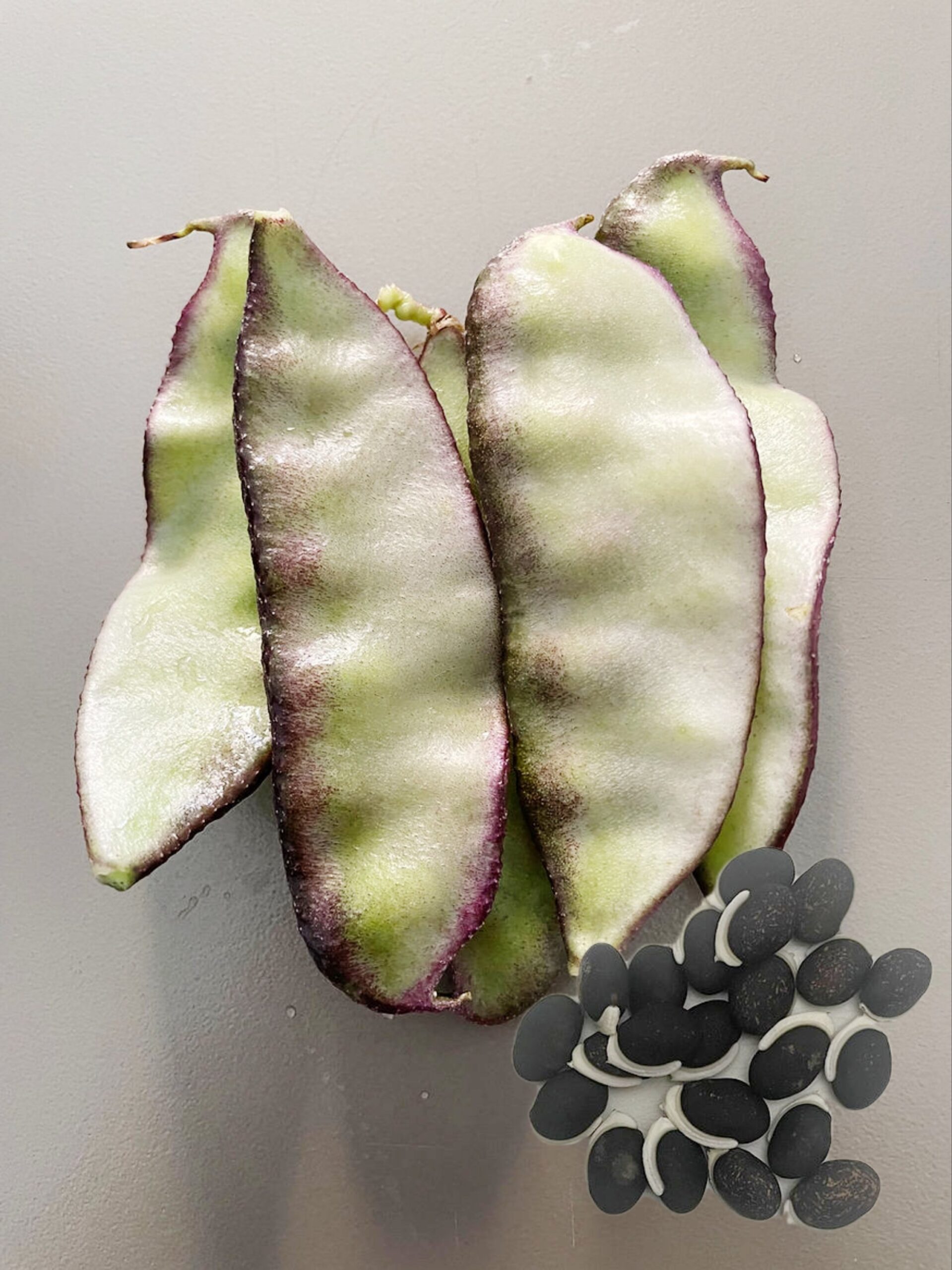Green with Purple Elephant Broad Beans are a unique and visually striking variety of broad beans (also known as fava beans), known for their distinctive color pattern and large size. Here’s a detailed overview of this special type of broad bean:
1. Appearance:
-Beans: These broad beans are characterized by their **green color with purple markings**, which makes them stand out compared to other types of broad beans. The beans are large, flat, and kidney-shaped.
– Size: The “Elephant” in the name refers to the large size of both the beans and the plant. The beans themselves are notably larger than those of standard broad beans, with a plump and meaty texture.
– Pods: The pods are typically long, broad, and filled with 4-7 beans. When immature, the pods may also show a slight purple tint, though they are usually green as they mature.
2. Plant Characteristics:
– Growth: The plant grows to a substantial height, often reaching 4 to 6 feet (1.2-1.8 meters). This tall, sturdy growth makes them well-suited for gardens with ample space or for growing in a row, as they need space to spread.
– Vigorous and Strong: Known for their robust growth, the Elephant broad beans are resilient plants that can tolerate cooler weather and are resistant to some common diseases that affect other broad beans.
– Flowers: The plants produce white or pale pink flowers, often with purple veins, which eventually develop into the characteristic broad bean pods.
3. Cultivation:
– Climate: Like other broad beans, these beans thrive in **cooler climates**. They are typically planted in early spring or late autumn, when temperatures are mild and frost is no longer a concern.
– Growing Conditions: They prefer fertile, well-drained soil and full sunlight. Broad beans are hardy and can tolerate light frost, which makes them an excellent crop for early-season planting.
– Harvesting: Beans are harvested when the pods are fully mature, though they can be eaten young as well. The beans need to be removed from the pods and cooked thoroughly before consumption, as raw fava beans can contain toxins that are neutralized by cooking.
4. Nutritional Value:
– Protein-Rich: Broad beans, including the green with purple elephant variety, are a great source of plant-based protein, making them an excellent choice for vegetarians and vegans.
– Fiber: These beans are high in dietary fiber, which supports digestive health and helps maintain stable blood sugar levels.
– Vitamins & Minerals: Green with purple elephant broad beans are rich in essential nutrients such as iron, magnesium,potassium, folate, and various B-vitamins.
– Low in Fat: Broad beans are generally low in fat, which makes them heart-healthy.
5. Culinary Uses:
– Fresh Beans: The beans can be eaten fresh, usually after blanching or boiling them, and can be added to a variety of dishes such as soups, stews, salads, and pasta dishes. They can also be mashed or pureed to make spreads or dips like fava bean dip.
– Dried Beans: When dried, these beans can be stored for longer periods and are typically used in hearty soups, curries, and stews. The dried beans should be soaked overnight before cooking.
– Flavor: These beans have a mild, nutty flavor and a creamy texture when cooked, making them versatile for a wide range of culinary applications.
– Cultural Dishes: In Mediterranean, Middle Eastern, and North African cuisines, broad beans are a staple ingredient. They are often included in dishes like ful medames (Egyptian fava bean stew) and various tagines.
6. Health Considerations:
– Toxicity: Like all broad beans, Green with Purple Elephant Broad Beans contain naturally occurring toxins (such as vicine and convicine), which can cause a condition called favism in susceptible individuals. These toxins are neutralized by cooking, so the beans should always be thoroughly cooked before consumption.
– Fava Bean Allergy: People with favism (a genetic disorder affecting the metabolism of certain compounds in fava beans) should avoid consuming these beans, even if they are cooked.
7. Storage:
– Fresh Beans: Fresh beans should be stored in the refrigerator and used within a week. You can also freeze them after blanching to extend their shelf life.
– Dried Beans: Dried beans can be stored in a cool, dry place in an airtight container for several months. When ready to cook, dried beans should be soaked overnight and boiled thoroughly to soften them.
8. Other Uses:
– Fodder: In some regions, the plants are also grown as livestock fodder due to their high-protein content.
– Ornamental: Due to the plant’s tall growth and attractive flowers, these beans can also be grown as ornamental plants in gardens.














Reviews
Clear filtersThere are no reviews yet.